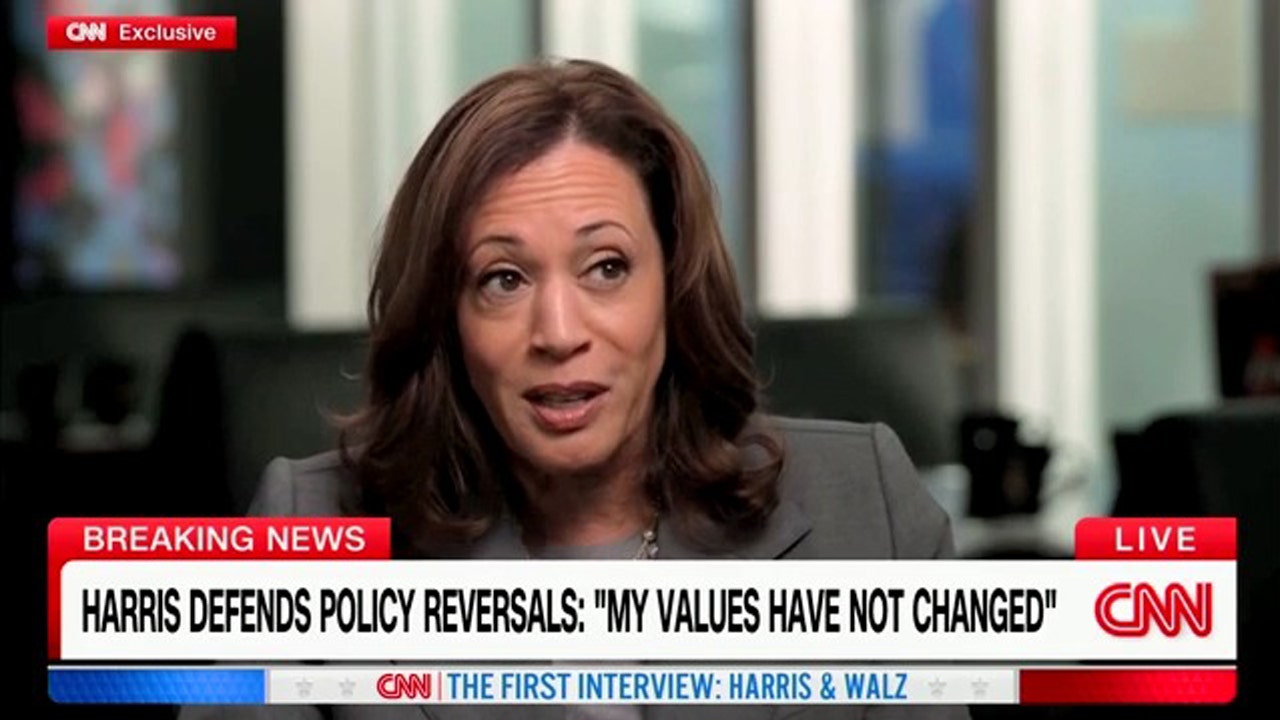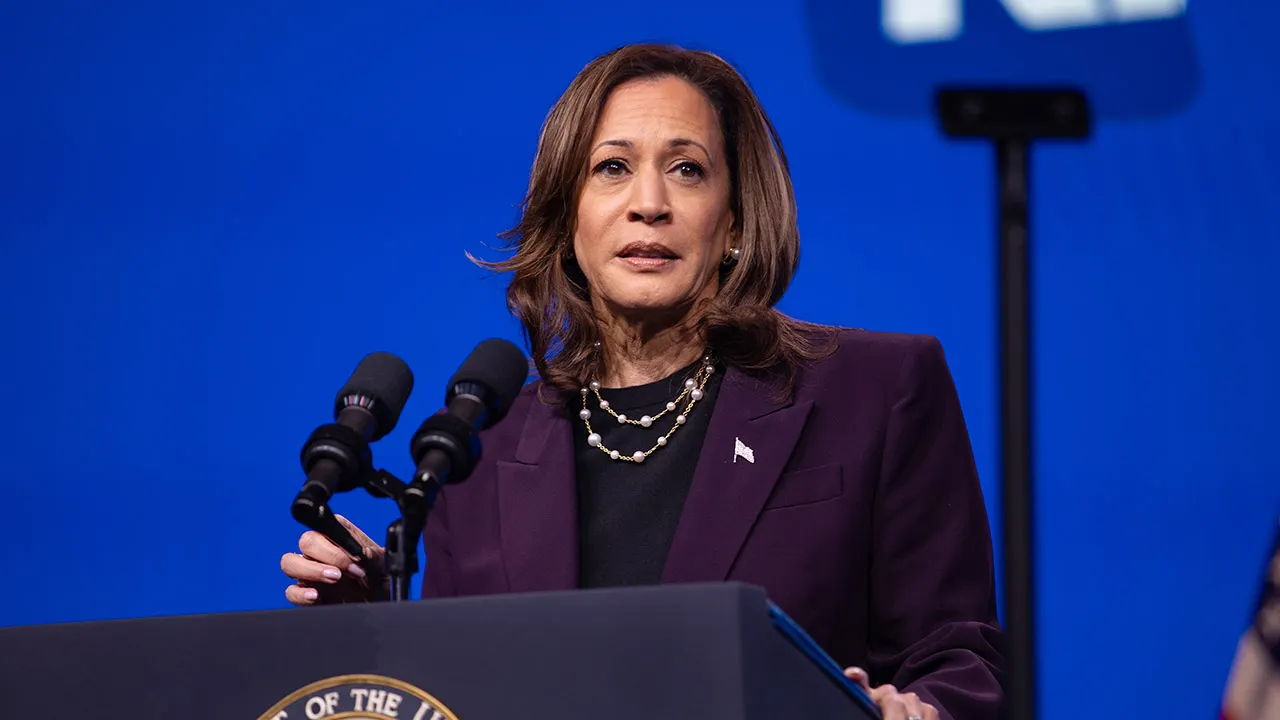Sports
Gardena overwhelms 19-player Crenshaw team in blowout victory

Marcus Martin, who was a giant All-City lineman during Crenshaw High’s City Section championship football seasons of 2009 and 2010 before moving on to USC, then the NFL, stood on the sideline Thursday looking straight into the eyes of four Crenshaw lineman as the sun was beginning to go down in Gardena. The scoreboard clock was running nonstop in mercy mode in the fourth quarter with Gardena ahead 52-0.
Martin, serving as a Crenshaw assistant coach for a team playing with 19 players in its first game of the season, was doing some teaching.
“Whatever happens, I’m proud of you,” he told the linemen. “We did the best we can. Don’t hold your head down. Hold it up.”
Yes, there is a way forward for the once powerful Crenshaw Cougars. They have a strong coaching staff, headed by coach Robert Garrett, in his 37th season. But the small roster of players combined with playing the defending Marine League champions was always going to lead to a running clock. That’s how much more skilled the Panthers are.
Gardena (2-0) has one of the best running backs in the City Section in senior Xavier Grant, an Air Force commit who rushed for 117 yards in four carries and scored touchdowns on runs of 53 and 40 yards as the Panthers held a 45-0 halftime lead. At one point in the first half, Gardena scored touchdowns on four consecutive offensive plays.
Quarterback Isaiah Kim completed nine of 11 passes for 210 yards. He had two touchdown passes to D’Maj Longley (12 and 59 yards) and another to Akiah Brown (three yards). Myles Mason broke off touchdown runs of 48 and 11 yards. The whole second half was played with a running clock.
Gardena has a pair of tough, powerful defensive linemen in Shane Mailo and David Frankling. Crenshaw lost the ball twice on fumbles, with Frankling scoring on a 14-yard fumble recovery.
Gardena wide receiver D’Maj Longley runs for a touchdown as Crenshaw cornerback Daniel Daniels reacts during the Cougars’ loss.
(Michael Blackshire / Los Angeles Times)
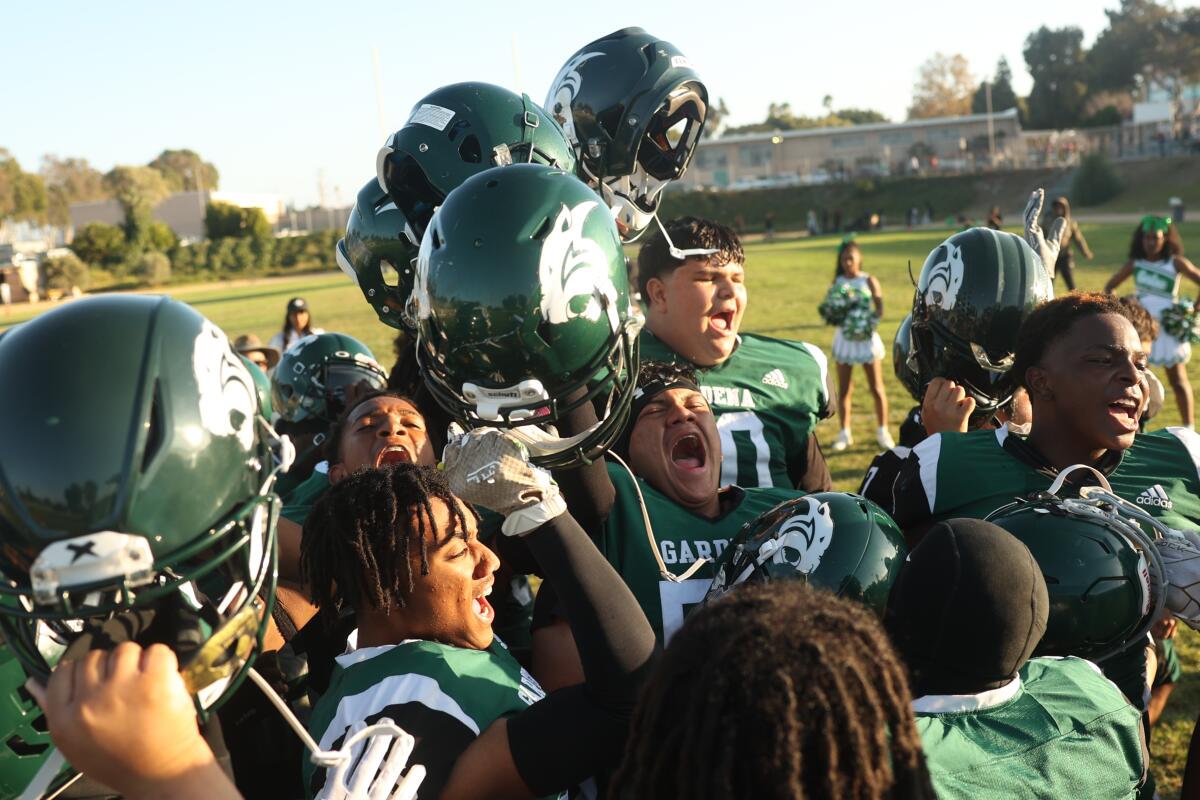
Gardena players celebrate their 52-0 victory over Crenshaw on Thursday.
(Michael Blackshire / Los Angeles Times)
For those who have been following City Section football, it used to be Crenshaw as the power and Gardena finishing with back-to-back 0-10 seasons in 2016 and 2017. Monty Gilbreath, a former Taft receiver, took over as head coach in 2021, and has benefited by having a group of players who’ve played together since their youth days.
Gilbreath is having to balance coaching and going to see his son, Chaz, a standout junior receiver for Mayfair. “They really look out for my son,” he said.
What’s clear is that Crenshaw, which has an enrollment of 549 students, far down from the days over 2,000, is in teaching mode. Under Los Angeles Unified School District rules, teams have to have at least 18 players available to start games. Building up the roster has to be a priority.
Cougars quarterback Sir Rey Tyler-Matthews did his best under constant pressure. In the fourth quarter, he broke off a 32-yard run to the Gardena 12 before the drive stalled.
Crenshaw plays Hamilton next week while Gardena takes on Compton Centennial.

Sports
Jayson Tatum discusses ‘debate’ over Olympic benching, Celtics’ NBA title and more

Some things never change for Jayson Tatum. As his career has continued to ebb and flow, there has been one constant: Tatum finds himself at the center of conversation.
He broke onto the NBA scene as an impressive role player when he was 19, only to oscillate in the public eye between auspicious and overhyped. Leading the Boston Celtics to a title in June gave him a championship pass, a final word to put questions of his stardom to bed.
But it took just a few weeks for the conversation to start again. This time, the tenor was different. As a member of Team USA, Tatum (alongside Pacers guard Tyrese Haliburton) didn’t make it off the bench in the Olympics opener against Serbia. Though Tatum played in four of the other five games — he sat again against Serbia in the semifinals — his benching became one of the talking points of the tournament.
“It’s one of those things where there’s been so much talk and debate,” Tatum said. “There was a period of is he a superstar or not? Then it was a big debate, like, is he championship ready now? Then it’s like how could he not get in the (Olympics)? I’m like, I just won a championship, it’s the summertime, it might be nice to have a little break where you don’t turn on ESPN and they’re talking about you. But I guess this is part of it, and that may be the level that I’ve reached now in my career.”
Relive the Boston Celtics’ incredible 2024 championship season. Garden Party takes the reader from preseason all the way until the last minute in Boston.
Relive the Boston Celtics’ incredible 2024 championship season.
Buy
Even though he was in the Olympic Village and avoided discussing it publicly while the Games were still going, Tatum was aware of what was happening outside of Paris. And while this was one of the rare times in which the public seemed to have his back, it still wasn’t easy for him.
“It was a lot. In the age of social media, you see everything,” Tatum said during a phone call. “You see all the tweets and the people on the podcasts and people on TV giving their opinion on whether they thought it was a good decision or it was an outrageous decision or whatever. Obviously, I wanted to contribute more, and I’ve never been in (this) situation. I started playing basketball at (age) 3 at the YMCA, and I’ve never not played, so it was different and it was challenging.”
Team USA head coach Steve Kerr attributed his decision to matching up against Nikola Jokić and the big Serbia roster, then proved he meant it by playing Tatum in every remaining game except for the Serbia rematch in the semifinals.
Ironically, his Celtics teammate Jrue Holiday was a beneficiary of Tatum’s benching as he started those matchups against Serbia. But Holiday said Wednesday he felt the whole situation might have been blown out of proportion with the amount of coverage it got across the basketball world.
“When you see it everywhere all the time and people are talking about it and I’m hearing about it all the time, I’m like, ‘Man, I can only just imagine what he’s going through,’” Holiday said. “I feel like he enjoyed himself and I feel like that’s a part of the experience, is enjoying it. I hope he got a chance to (enjoy) it, because I did. It’s fun to play with him and (Derrick) White, but then it’s also fun to play with some of the best players ever.”
“I wasn’t moping around. I didn’t have an attitude. I wasn’t angry at the world,” Tatum said. “I stayed ready and did what was asked of me and I won a gold medal, right?”
Beyond the rotation limitations, there was another reason for Tatum to get knocked down the depth chart. After shooting lights out in the second half of the regular season, he has been on the worst cold streak of his career since the playoffs began.
“I know I didn’t make a jump shot when I was with Team USA. I don’t know, law of averages,” Tatum said. “It’s a weird rhythm thing being with Team USA; you never exactly know when you’re gonna get the ball. But that’s part of it. You sign up for that because I’ve done it before (at the Tokyo Games).”
Tatum and those around him have maintained he is not injured and hasn’t lost confidence in his shot. Though he shot 28.3 percent from deep in the playoffs and missed every jumper he took while on Team USA, he said he’s been playing basketball long enough that he’s not worried about getting back on track by October.
“I have two (gold medals) now, I have a championship, and everything doesn’t necessarily go the way you expect it to go, right?” Tatum said. “I’ve learned to be like, ‘OK, that’s a part of it.’ You move on, and I’m getting ready to enjoy the last little weeks I have before the season starts and get ready for another season.”
Tatum’s summer has been full of success on and off the court. He was named the NBA 2K25 cover athlete, he has a children’s book coming out Sept. 10, and he signed the largest contract extension in NBA history (for now).

Jayson Tatum lifts his son, Deuce, after the Celtics won the NBA title at home in Boston. (AP Photo/Charles Krupa)
Things have finally slowed down, so Tatum can focus on spending the rest of the summer with his 6-year-old son Deuce before he starts first grade. As Tatum continues to learn how to handle the increasingly bright spotlight, his son is starting to understand who his father is to the rest of the world.
“Being at school, I guess, made him realize how big of a deal it was (for) us winning a championship or competing for it,” Tatum said. “He just thought that was normal until he went to school and people are talking about the Celtics and us winning and us trying to compete for a championship. I think he realized the magnitude of that, being around kids his age and even the older kids in fourth, fifth grade.”
Last season he would show up to Deuce’s school often to spend time with his son’s classmates and teachers. Tatum said he loved reading to his son’s class as the kids got excited. Deuce got a taste of what it was like to be his dad when he was the talk of his school as a kindergartner. While his son is growing up fast, Tatum said he’s is learning as a parent to let go.
“I’m not gonna lie, I was nervous, at first, to send him to school,” Tatum said. “Just because you’re putting your most prized possession, your own child, in the care of somebody else five days a week, which is obviously a normal thing. Kids go to school. But at first, I was nervous.”
Once Deuce starts school, Tatum can turn his attention to his day job. His goal for the Celtics is to make sure they don’t lose their sense of urgency next season. He said they will have to fight the urge to be complacent, something they succeeded with last year under Joe Mazzulla.
The Celtics were fitted for their rings two weeks ago, and Tatum said everyone was excited by the process. When the team came into the facility earlier this month, he told everyone they needed to make sure their title celebration was short-lived once the games began.
“I’m of the mindset that after ring night, in a weird way, we got to put that behind (us),” he said. “Last year was last year. We did it. It was a dream come true. We worked our ass off for it. But after ring night, we gotta move on. We gotta get ready for game two.”
Tatum and the Celtics came up short so many times in the past before finally breaking through this summer. Just one championship changed their reputations and perspective, even though they came so close so many times.
But this summer wasn’t perfect for Tatum. With all his success came a humbling experience as well. Those moments in prior seasons helped hone him into the Celtics’ best player, a now officially championship-caliber superstar. So the Team USA benching, even if it may have been blown out of proportion in the grand scheme of things, may benefit Tatum in the long run.
“I’m always a glass-half-full type of guy,” he said. “I always believe everything happens for a reason and whatever that is, I don’t know yet. But I’m certain I’ll find out.”
(Top photo: Ezra Shaw / Getty Images)
Sports
Carlos Alcaraz upset in second round at US Open by Botic Van De Zandschulp in straight sets
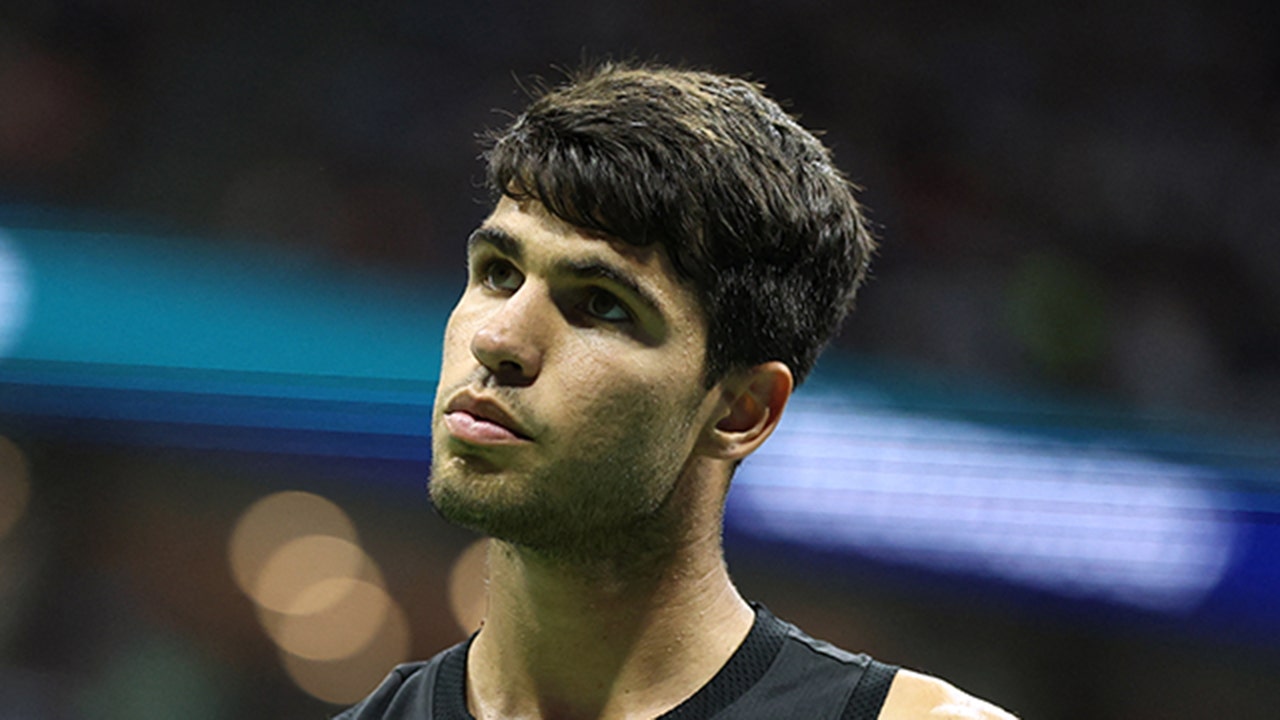
One of the frontrunners in men’s singles to win the 2024 U.S. Open has been knocked out in the second round.
Spanish phenom Carlos Alcaraz, winner of the French Open and Wimbledon earlier this year, was shockingly upset in the second round by the Netherlands’ Botic Van De Zandschulp in straight sets.
Van De Zandschulp, the 28-year-old from Wageningen, Netherlands, was only 87-83 in his career and 10-18 this year when he entered his match against Alcaraz after defeating Denis Shapovalov in the first round.
Carlos Alcaraz of Spain hits to Botic van De Zandschulp of the Netherlands on day four of the 2024 U.S. Open tennis tournament at USTA Billie Jean King National Tennis Center. (Robert Deutsch-USA TODAY Sports)
But it was clear from the start of the match that Van De Zandschulp was not at all nervous to be facing Alcaraz, the 21-year-old, four-time Grand Slam champion.
Van De Zandschulp won the first set convincingly, 6-1, where Alcaraz airmailed a serve return over the baseline on triple set point.
DEFENDING US OPEN CHAMPION COCO GAUFF SAYS SHE BLOCKS CYBERBULLIES ON SOCIAL MEDIA AMID PLAYER CONCERN
From there, the Spaniard kicked it up a notch, but Van De Zandschulp was still able to win the set via tiebreak, 7-5, to put himself in the driver’s seat to pull off the major upset.
We’ve seen what Alcaraz can do with his back against the wall in the past, but Van De Zandschulp outlasted him yet again in the third set, finishing him off, 6-4, in front of a stunned New York City crowd.

Botic van De Zandschulp of the Netherlands after beating Carlos Alcaraz of Spain on day four of the 2024 U.S. Open tennis tournament at USTA Billie Jean King National Tennis Center. (Robert Deutsch-USA TODAY Sports)
Just like that, the No. 3-ranked men’s singles player in the tournament, and a large fan favorite, is out at the final Grand Slam of the year. Alcaraz had not lost at the U.S. Open before the quarterfinals in three previous appearances.
Alcaraz entered Thursday without losing in a Grand Slam in 15 matches. But, while Van De Zandschulp was exceptional, especially when the ball was on his forehand, it was a sloppy all-around performance by Alcaraz, who hurt himself too many times.
Van De Zandschulp has faced Alcaraz two previous times, both of which were won by the Spaniard. However, serves from the lanky Dutchman were overpowering Alcaraz as they reached 132 mph on the radar.
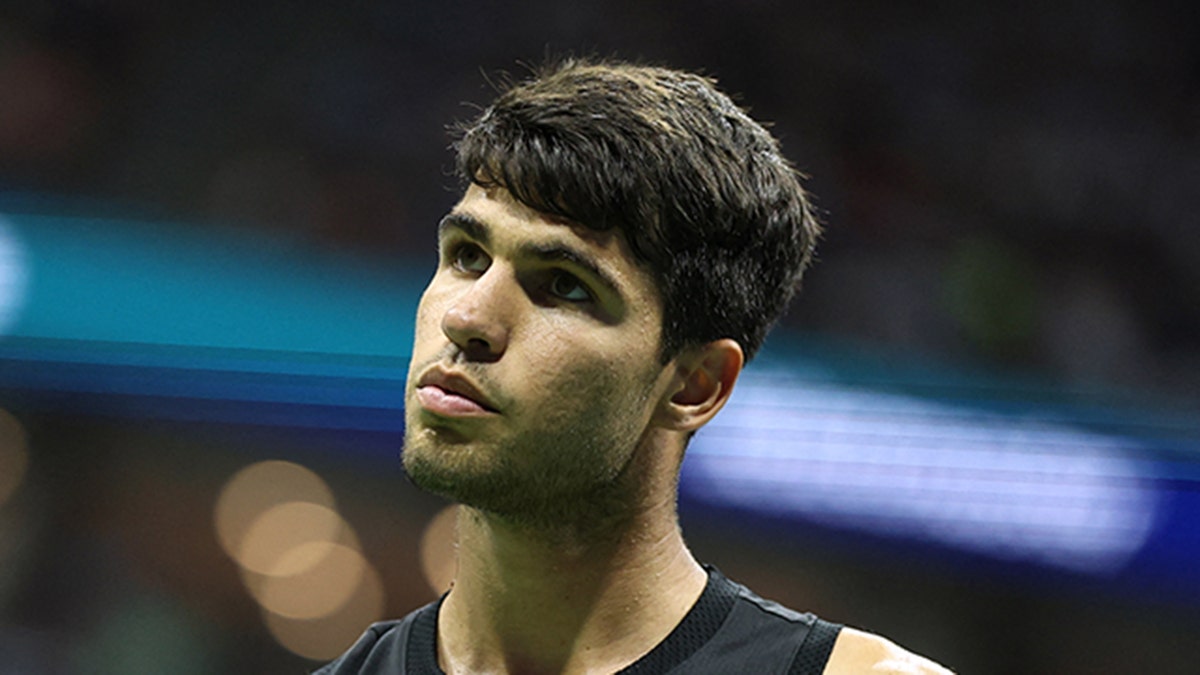
Spain’s Carlos Alcaraz reacts during his men’s singles first round match against Australia’s Li Tu on day two of the US Open tennis tournament at the USTA Billie Jean King National Tennis Center in New York City, on August 27, 2024. (CHARLY TRIBALLEAU/AFP via Getty Images)
As Alcaraz looks back at the tape to figure out what went wrong, Van De Zandschulp will move on to the third round, where he’ll face another ranked opponent – No. 25 Jack Draper from Great Britain.
Follow Fox News Digital’s sports coverage on X, and subscribe to the Fox News Sports Huddle newsletter.
Sports
Selhurst Park at 100: Why one of England’s least loved grounds really matters

“I never realised what a magical world it was. It was just people and families and colour and joy. The smell of hotdogs, people selling scarves and souvenirs. It was like I’d gone into this magical world I didn’t even know existed,” Hy Money, photographer and Crystal Palace fan, of her first visit to Selhurst Park in 1971 (cpfc.co.uk).
Not everyone sees the magic, admittedly. If you prefer a modern stadium with a park-and-ride next door and a bit more legroom, Selhurst Park is never going to figure on your list of favourite grounds.
Maybe you have sat in the away end and been able to see only two-thirds of the pitch. Maybe you don’t understand why a large Sainsbury’s supermarket is tacked onto one side of the stadium. Or maybe a bit of snobbery has set in after all these years of the tills-ringing Premier League.
Simon Inglis, the author and football historian, recommended as long ago as 1983 that Crystal Palace might be better off without the stadium that Archibald Leitch, the architect who designed it, predicted would be the biggest in London.
Inglis took the view — “to be really provocative” — that the club should share the athletics stadium two miles away. Leitch’s portfolio included Stamford Bridge, Craven Cottage, Anfield, Goodison Park, Old Trafford and many more. Selhurst Park, Inglis wrote, was “never one of Leitch’s best”.
Archibald Leitch’s Main Stand under construction at Selhurst Park in 1924 (Osbourne/Topical Press AgencyHulton Archive/Getty Images)
And fair enough, even if Inglis mentions in his renowned book, Football Grounds of Britain, that the unorthodox look of Selhurst Park is also part and parcel of its character and appeal.
Tomorrow (August 30), it will be 100 years old. Yet Palace fans should know from experience that not everybody will want to commemorate the anniversary. Selhurst Park gets a bad name sometimes. Barring Goodison Park — which Everton are vacating at the end of this season for a new 53,000-capacity ground — it is the least recently developed stadium in the Premier League and ranked 18th in The Athletic’s survey of Premier League grounds last year.
And yet, there is plenty to like, too. Look closely enough and maybe, this week of all weeks, attitudes can soften and we can show some love to one of English football’s most unappreciated stadiums. Because there is more good than bad, even if it has been a close-run thing at times.
“It’s not iconic,” says Steve Coppell, one of the managers who count as Selhurst Park royalty. “It’s not architecturally unique or superb. Opposition teams hate it because the dressing rooms are so small. It’s quirky, it’s difficult to get to. It’s a patchwork quilt of a stadium — but if you are a Palace fan, you love it.”
“Why did the media relish slagging off Selhurst Park so much? There’s one big reason: the media facilities aren’t that great. And why’s that? Because the media have consistently had a go at me for the last five years, so I took their biscuits away,” Simon Jordan, Crystal Palace owner, 2000 to 2010, in The Guardian.
Head along Whitehorse Lane, past the Mayhem vape shop, the Dutchie (Caribbean food), Danyame’s Kitchen (Afro-Ghanaian) and the boarded-up shell of what used to be the London Tavern pub and the first entrance to Selhurst Park comes in the form of the Sainsbury’s superstore that has adjoined the stadium for more than 40 years.
Supporters of a certain generation might be familiar with the parade of shops where the players used to get their lunch at Berto’s cafe and the barber’s, which had pictures on its walls of the owner, Enzo, trimming the hair of Don Rogers, one of the crowd favourites.
It is a different selection of shop names and food places these days. The Original Tasty Jerk, where Berto’s used to be, is reputed to sell the best jerk chicken in south London (and there is plenty of competition for that title): if the wind is blowing in the right direction, the smell drifts over the fan zone into the stands on matchdays. In 2017, Palace even nodded to its popularity by tweeting a video of its chimney puffing white smoke — ‘Vatican-style’ — in anticipation of the announcement of Frank de Boer as manager.
💭💭💭 pic.twitter.com/ruXld8jy08
— Crystal Palace F.C. (@CPFC) June 26, 2017
The opposition on August 30, 1924, was The Wednesday — or Sheffield Wednesday, as they became known — and the first game at Selhurst Park featured the early symptoms of a condition that is sometimes known among modern-day fans as “typical Palace”. They lost 1-0. The goal was scored after four minutes and the official opening by the Lord Mayor of London took place in a still unfinished stand because of delays and strikes.
A century on, it is still possible to find families in the nearby streets who, going back through the generations, have lived here even longer than the stadium on their doorstep. Stickers on Holmesdale Road’s lamp-posts proclaim, Sex Pistols-style, “Never Mind the Brighton, Here’s the Palace.”
The mural for Wilfried Zaha at the junction of Park Road brings a dash of colour to the suburban backcloth (just a shame, perhaps, that he left for Galatasaray a couple of months after it went up). In the Clifton Arms, the closest pub to the ground (“Home Fans Only!”), the beer garden is splashed in Palace colours.

The Wilfried Zaha mural at Selhurst Park (The Athletic)
What has never changed are the gripes and sneers that have attached themselves to this part of SE25, in the London borough of Croydon, for longer than Palace fans would probably wish to remember.
“The location, mainly,” says Coppell, with the weary tone you might expect of someone who has been hearing these complaints for four decades. “I get loads of people asking me, ‘What’s the best way to get to Selhurst Park?’. I say to them, ‘There is no best way — tell me what time you’re going, where you’re coming from, and I will tell you what is probably the best way’. But I could tell them the best way and they still might be stuck in traffic for an hour and a half.”
Coppell had four spells as Palace manager, including a transformational nine-year stint when he took the club back into England’s top division, led them to their first FA Cup final and, in 1990-91, their highest finish of third place.
Crowds had dipped below 6,000 in Coppell’s first year in charge and the Holmesdale Road end, now the biggest of Selhurst’s four stands and home to its most boisterous fans, was “just a mound behind the goal” — a rough bank of concrete terracing with metal fences at the front and a chunky, angular floodlight in each corner.
Palace, Coppell recalls, were skint — not bucket-collection broke, but skint all the same. Various events were put on to raise money, including a “gentleman’s evening” with comedian Bernard Manning. It was the ultimate indignity — Manning preferred to get his dinner from the chip shop rather than eat whatever the club dished up.

Selhurst Park with the old Holmesdale terrace in the foreground (Anton Want/Allsport/Hulton Archive/Getty Images)
As for the manager’s office, that was another part of the stadium’s irregular design. “It was above a fish and chip shop,” says Coppell. “It’s the souvenir shop now but, back then, it was a chippy called ‘The Seafarer’. My office was baking hot because of the heat coming through from the fryers and it stunk of fish and chips.”
The context here is important. In 1924, Palace were a year away from falling into Division Three South. They could afford to install a tap by the trainer’s bench for wetting the magic sponge. Despite their regal name — shared with the area of London slightly to the north of Selhurst Park where Palace originally played — the club did not have the money for the brick detailing, roof gables and fancy trimmings that Leitch added to Highbury and Stamford Bridge.
In the 100 years since, Palace have never had the wealth of London’s more glamorous clubs — and that, more than anything, explains why their stadium has only had sporadic development, bit by bit, and why Jordan recalled it being in “an absolute state of disrepair” when he began his 10 years of ownership.
“Virtually everywhere you looked, it was coming down,” Jordan writes in his autobiography, Be Careful What You Wish For. “The lounges were like the inside of a restaurant that hadn’t been redecorated since the 1970s.”
That was 2000 and, within a week, a letter had arrived to inform Jordan the roof on the Arthur Wait stand was unsafe and needed replacing as a matter of urgency. “The safety council for the Football League told me I had three weeks to do it or close the stand for the season,” he recalls.
The training ground in nearby Mitcham was even less salubrious (it should have been “condemned” is Coppell’s take) and still had the communal bath that became infamous because of the 1976 photograph of Malcolm Allison — showman, playboy and, back then, Palace’s manager — sharing the water with soft porn actress and vicar’s daughter Fiona Richmond.

Malcolm Allison was a flamboyant manager for Crystal Palace (Michael Webb/Keystone/Getty Images)
So where did managers in those days take prospective new signings when they were trying to convince them to join the club?
“Most of my business was done at the old Happy Eater restaurant on Junction 7 of the M25,” says Coppell. “It (Selhurst) was better, marginally, than the training ground. But it was always bibs and braces. It certainly wasn’t anywhere you took a player to impress them.”
“At Selhurst Park, the tunnel is in the corner of the ground, so staff have to walk alongside the Main Stand to get to the dugout. It can be a long walk if the crowd don’t like you,” Neil Warnock, twice Crystal Palace manager.
On Saturday, when Palace were beaten 2-0 at home by West Ham United, the club announced the presence of a new American bald eagle to fly inside Selhurst Park before matches.
Phoenix, a four-month-old, will swoop down from the stands as Palace’s official mascot, filling the void left by Kayla, who had 10 years in the role and once had the temerity to steal a pie from a Millwall supporter. Kayla survived an attempted punch from a Charlton Athletic fan in 2015 but died of old age four years ago.

The club had put together a commemorative programme to mark the stadium’s centenary. Its front cover was a well-intentioned but slightly odd graphic of manager Oliver Glasner deep in discussions with Leitch over some architectural drawings. And just up the hill from the away end, one of the programme sellers was cheerfully advertising its availability, town crier-style, while poking some fun at West Ham. “Palace against little Spurs, cheap and nasty little Spurs…”
It is not short of attitude, this place. “All these new, identikit, 30,000-capacity grounds have gone up and they all look exactly like each other,” says Neil Witherow, a Palace fanatic and former writer for the club’s original fanzine, the Eagle Eye. “Then you go to Selhurst and there are four different stands, including two particularly ramshackle ones and one where they built a supermarket. And yet, I’d much rather be here than playing in a soulless, concrete bowl.”

Selhurst Park looking south, with Croydon town centre in the background (Mike Hewitt/Getty Images)
Witherow went on to edit Palace Echo, a fanzine named after the fictitious noise that fans in the 1980s imagined would be created by putting a roof over the Holmesdale Road terrace.
He has written a book about his devotion to the club, Don’t Mention the ‘Spor, and tells an emotive story about breaking down in tears when he returned to Selhurst Park after the Covid-19 lockdown and realised it was 50 years to the day since his first match.
“There is a new generation of football fans for whom the London Stadium (West Ham), the New Den (Millwall) and all those other modern grounds are all they have ever known,” he says. “Then they come to Selhurst as an away fan and, ‘What the f*** is this? It’s archaic!’. It’s not the most attractive football stadium in the world, but it’s mine.”

From his seat in the third row of the Holmesdale upper tier, Witherow can testify that the views are spectacular of “this massive expanse of sky, the big hill in the distance, the famous house on the hill (Kilravock House, once featured in a Sherlock Holmes short story), Grangewood Park, the planes going into Heathrow… it’s just majestic, especially if what’s happening on the pitch isn’t too clever”.

The view from the top of the Holmesdale stand, with Kilravock House top right (Bryn Lennon/Getty Images)
It is noisy, too. The fan culture, led by the Holmesdale Fanatics, has turned up the volume inside Selhurst Park to the point that Alan Smith, another of Palace’s popular ex-managers, says the ground is “up there among the top five in the country for atmosphere these days”.
It is just an oddity, perhaps, that arguably the three most famous goals ever witnessed on its pitch were all the work of opposition players.
One was David Beckham scoring from the halfway line for Manchester United. Another was Tony Yeboah’s volley for Leeds United, thwacking in off the underside of the crossbar. Or perhaps you remember Dalian Atkinson’s chip for Aston Villa in 1992 and the comedic value, amid the drizzle of a grey October afternoon, of an away fan running on the pitch to hold an umbrella over his head in the celebrations.

The oddest part? The ‘home’ side on every occasion was Wimbledon, who had replaced Charlton Athletic as tenants in a ground-share that many Palace fans disliked but helped save their club, which has twice been in administration since.
Long-time supporters might prefer to reminisce about the ‘Team of the ’80s’, which briefly went top of the old Division One and featured seven players from south London, as well as two others from different parts of the capital. The manager was Terry Venables and promotion arrived in a Friday-night fixture against Burnley in 1979.
“Officially, the attendance was 51,000 but, depending on who you believe, it was 61,000 or even 71,000,” says Kevin Day, the comedian and Palace fan. “I’ve never seen anywhere more packed. At least I can tell people, ‘I was there’. We won 2-0 and my memory of Dave Swindlehurst’s goal was ending up about 40 yards further down the Holmesdale terrace than where I’d begun.”
Day’s addiction began in April 1971, at the age of nine, watching a 3-2 win against Stoke City in a season that finished with Palace 18th out of 22 clubs. He was hooked instantly.
“I just knew instinctively that it wasn’t like the grounds I had seen on television,” he says. “Over the decades, I’ve imposed all sorts of nostalgic, rose-tinted memories on going to Selhurst Park for the first time, seeing this magnificent green pitch and falling in love with it.
“In reality, two of the stands had no cover, our pitch was terrible and there were probably only a few bits of grass in the corners. But I still loved it. It felt like home and it has always felt like home.
“It’s a few years later when you realise you’ve picked the wrong team to support, but that you’re stuck with them. Then you become so loyal to your club and so defensive that you start telling people, ‘Oh, Selhurst Park is a really nice ground’, even though you know it’s not.
“The four parts of the ground don’t look like they belong to each other and it’s built into this strange hollow that means that no matter which way you approach it, you always seem to be going uphill.
“You start thinking, ‘I’d quite like to have a ground like all the others’. You start going to away games and you can’t help think, ‘Every other bugger has got a roof at each end and nice toilets, why can’t we have that?’.”
It was not until the early 1990s that Palace replaced the banks of open terracing where, in a different era, pre-season training consisted of the players strapping bags of weights to their backs and running up and down the concrete steps.

Palace players are put through their paces in 1936 (A. Hudson/Topical Press Agency/Hulton Archive/Getty Images)
Ron Noades, the then chairman, also came up with the idea that a 24-lane 10-pin bowling alley could go beneath the new-look Holmesdale Road stand. The idea had to be shelved (the basement was prone to flooding and, until it was drained recently, a pool of water lay dormant for many years), but the development did at least turn down the volume a little on Selhurst Park’s critics.
“It was a towering addition that gave the club a proper football stadium look,” says Coppell. “It’s just been a slow progression. The new stand went up and, since then, there have probably been 15 to 20 models of what’s going to happen to the stadium.”
The latest designs can be viewed in a glass-encased model inside the stadium’s main entrance. Planning permission was granted last week and, if everything goes ahead, it will involve replacing the original Main Stand, a hodgepodge of metal stairwells, add-ons and brick extensions, with a soaring structure that will bump up capacity from 26,000 to 34,000.
Day’s seat is in the Arthur Wait stand, on the opposite side, and requires him to “peer round a stanchion” to see the action, meaning his season ticket is officially designated as ‘restricted view’ — something, he notes, which was not such a bad thing during the less aesthetically pleasing moments of the Roy Hodgson era.

The Holmesdale Fanatics create a raucous atmosphere (Marc Atkins/Getty Images)
This is also the stand where the away fans are seated. It has been there since 1969 and it is named after the club’s former chairman, a builder who worked on the construction himself. But it is tired and cramped and not a huge amount has changed since the days, half a century ago, when Josephine Minchella — Mrs Minchella the Peanut Seller — used to push a pram up and down the hill (“Peanuts forra sixpence”), selling a veritable cornucopia of boiled sweets, toffee apples and other treats.
“It’s become a standing joke where I sit that if you want to get a pint at half-time, it requires leaving your seat at 3.29pm,” says Day. “And it’s not ideal to miss 16 minutes of the first half when you pay as much for your season ticket as we do.”
Ultimately, though, Day will happily reminisce for hours about all the golden memories that have brought him back, week after week, season after season. And there are thousands of like-minded people who share these affections.
“For all the people calling it a s***hole, you do also hear a lot of people calling it a ‘proper football stadium’ or a ‘proper old ground’,” he says. “So there is a balance. We are proud that we are a bit of a throwback in terms of atmosphere and that it almost feels like a historical re-enactment going to Selhurst Park sometimes.”
“We need everyone at Selhurst Park pulling in the right direction and not just the players. We need the directors, the kit man, the programme sellers and the tea lady all in it together,” Ian Holloway, Palace manager, in The Sunday Mirror, 2013.
The saddest thing, perhaps, is that arguably the most renowned incident in Selhurst Park’s 100 years of existence spews up memories of that wild night against Manchester United in 1995 when Eric Cantona jumped into the stand to deliver his infamous kung-fu kick on an abusive fan.
Smith was in the opposite dugout to Alex Ferguson at the time. The former Palace manager recalls it being “scary and eerie” how quickly everything blew up, but he also makes a point that gets missed too often.
“The media glamorises the Cantona incident far too much,” he says, and if you are familiar with the tragic story of Paul Nixon from the next time the two sides played one another, you will understand why it grieves him and many others.
And, besides, there are all sorts of weird and wonderful stories that provide much happier memories from the 100 years since Palace left their previous home, The Nest, to move into this old brickfield site, bought for the princely sum of £2,570.
The times in the 1970s, for example, when head groundsman Len Chatterton used to flatten the pitch by driving onto the grass at half-time in a Volkswagen Beetle, known as the Flatterer, with heavy-duty rollers attached to the wheels — a foolproof idea, it seemed, until the vehicle broke down in one match, causing a considerable delay to the second half.

Palace’s John McCormick challenges Arsenal’s Charlie George at Selhurst Park in 1971 (Douglas Miller/Keystone/Hulton Archive/Getty Images)
Or the story of the TV psychic Ronald Markham, aka Romark, putting a curse on Selhurst Park because he had fallen out with Allison, the manager who decided that Palace should be known as the Eagles as it sounded more intimidating than their old nickname of ‘The Glaziers’.
Romark, for context, once tried to hypnotise Muhammad Ali into losing a heavyweight title fight against Richard Dunn (Ali won in the fifth round) and boasted he could drive through London blindfolded, only to crash into a parked police car while trying.
Nonetheless, his curse planted a seed of doubt in the Palace boardroom, especially as the subsequent match in April 1976 was a defeat in the FA Cup semi-final to Southampton. Coppell can recall the club’s chaplain being asked, a decade on, to exorcise the stadium.
Selhurst Park is also said to have its own ghost — supposedly of Billy Callender, the team’s former goalkeeper, who died by suicide in 1932 in the home dressing room. John J O’Connor, the football poet, turned it into verse, entitled The Ghost of Selhurst Park. And maybe there is a joke to be made about some of the other frightful sights that have been seen leaving the stadium in the early hours — mostly on their way out of Crystals nightclub, which operated here for more than 20 years before closing in 2017.
What Palace’s fans do not find amusing are the one-star reviews left on TripAdvisor and the apparent absence of knowledge relating to the stadium’s history and achievements. England played an international at Selhurst Park. Real Madrid visited for its first game under floodlights. The stadium hosted two matches in the 1948 Olympics. And yes, that is it on Ted Lasso, the Emmy-winning TV comedy series.

GO DEEPER
How Ted Lasso’s creators fell for Selhurst Park – the real, ramshackle ‘Nelson Road’
Still not getting any satisfaction? Speak to Bill Wyman, perhaps. It was Selhurst Park where the future Rolling Stone discovered his love of football, travelling to games on the 654 trolleybus from Anerley Hill and watching his idol, Johnny Byrne, as Palace recorded their biggest-ever win, 9-0 against Barrow in 1959.
It still feels like a shame, though, that the stadium’s 100th anniversary is imminent and, for all the usual reasons, the occasion will pass without the publicity or commemoration that would be guaranteed if it was one of the Premier League’s more glamorous grounds.

A mural gazes down on fans assembling at Selhurst Park on matchday (Eddie Keogh/Getty Images)
Yes, it is few people’s favourite away day, but Selhurst Park does have colour and din, tradition and history, and a bit of what Iain Dowie, another ex-manager, used to call ‘bouncebackability’. It matters. And it is one of the sport’s great survivors given the number of times Palace have contemplated boarding up the place to move elsewhere, with all the emotional disruption that causes supporters.
As for the most familiar complaint, why drive to a football match in London anyway? There are three railway stations — Selhurst, Thornton Heath and Norwood Junction — within a 15-minute walk of the stadium and, nearby, all sorts of pubs and food places.
More than 50 years since his first match, Day sums it up rather neatly. “There are a lot of good Palace fans,” he says. “You will hear the expression, more than once, that ‘it’s a s***hole, but it’s our s***hole’. And that pretty much sums up our relationship with Selhurst Park.”
(Top photo: Ryan Pierse/Getty Images)
-

 Connecticut6 days ago
Connecticut6 days agoOxford church provides sanctuary during Sunday's damaging storm
-

 Technology1 week ago
Technology1 week agoBreakthrough robo-glove gives you superhuman grip
-
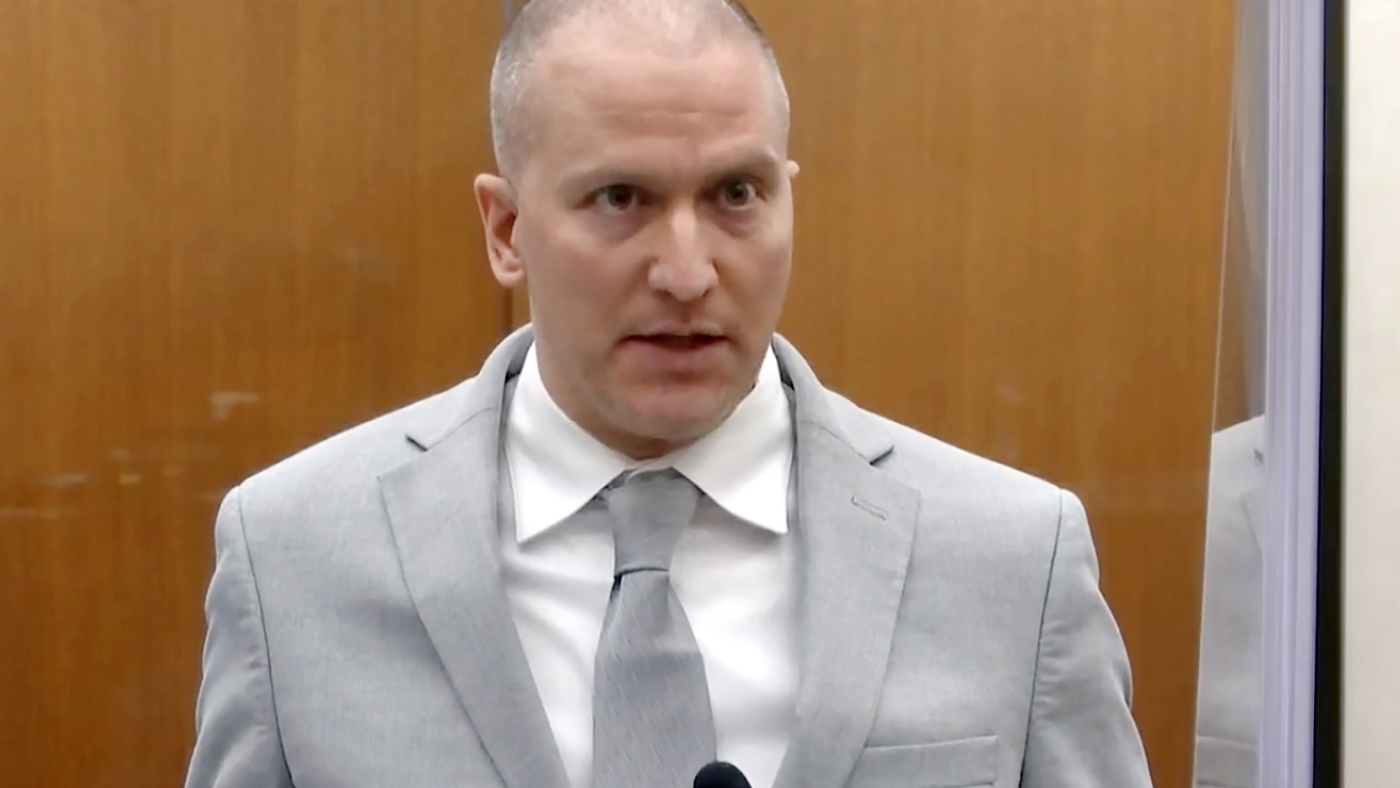
 News1 week ago
News1 week agoEx-officer convicted in George Floyd's killing is moved to new prison
-

 News1 week ago
News1 week agoVideo: Biden Delivers Keynote on First Night of D.N.C.
-

 News1 week ago
News1 week agoVideo: D.N.C. Holds Enthusiastic Roll Call to Nominate Harris
-
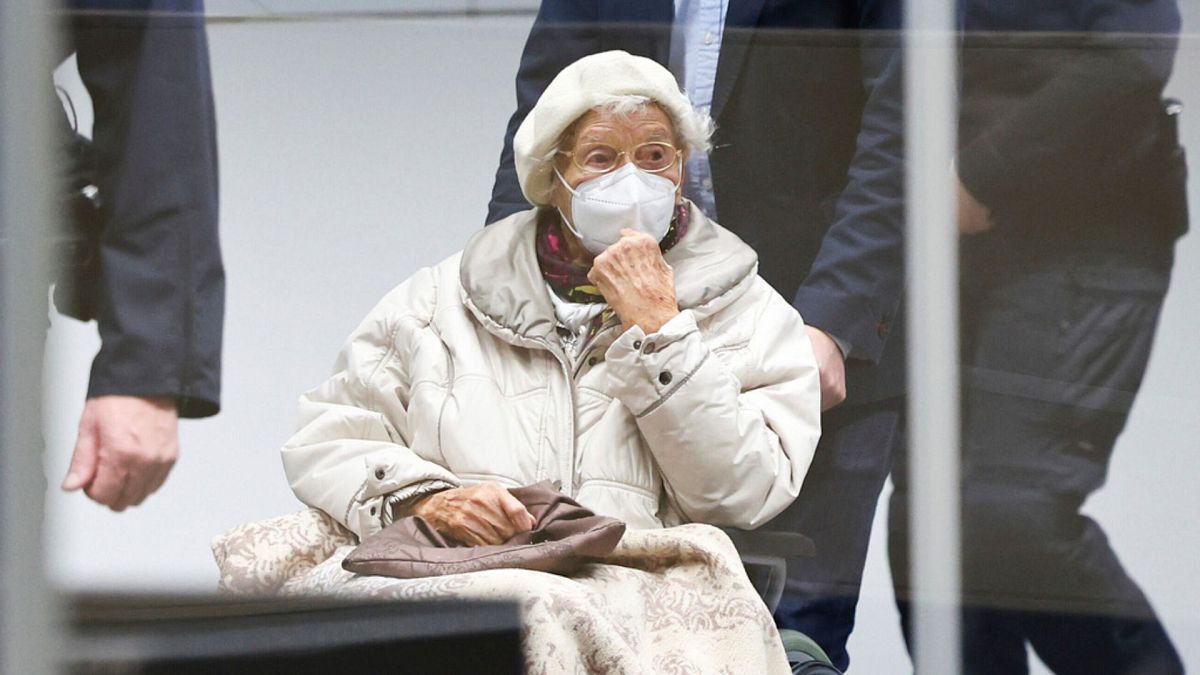
 World1 week ago
World1 week agoGerman court upholds conviction of former Nazi camp secretary, aged 99
-
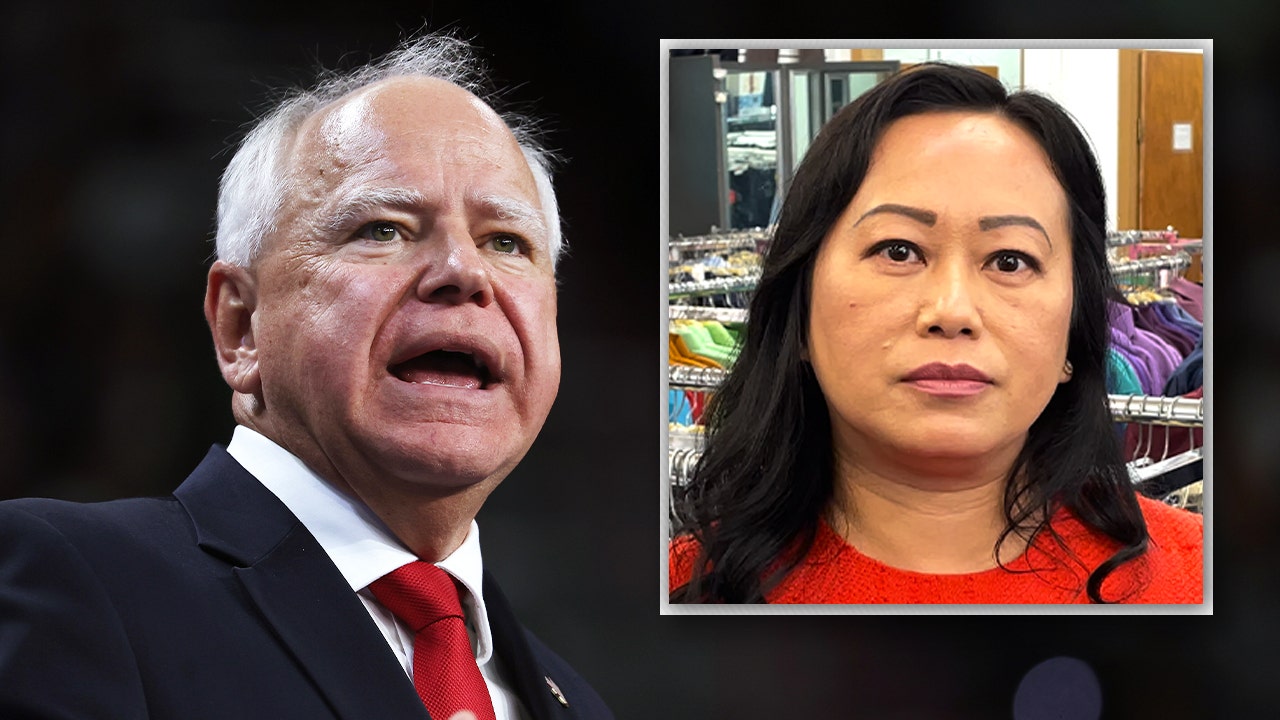
 Politics1 week ago
Politics1 week agoFormer teacher reveals which students suffered 'the most' under Walz's pandemic-era guidelines
-

 World1 week ago
World1 week agoPanama deports 29 Colombian migrants from Darien Gap under US deal










